Impact of Harmonic Currents of Nonlinear Loads on Power Quality of a Low Voltage Network–Review and Case Study
Abstract
1. Introduction
- ∔RMS value of the individual harmonic component of order for current,
- ∔RMS value of the fundamental harmonic (a component of order ) for current.
2. Review
2.1. Problems Caused by Harmonic Currents
- overheating and failure of transformers and other power equipment;
- false tripping of protection relays;
- overcurrent on equipment-neutral connection wiring;
- errors in the operation and control of sensitive devices (e.g., microprocessors); and
- interference with communication signals (digital technology), and others.
2.2. Recent Research
2.3. Problem Description
- the current harmonic pollutions generated by a load depend on the voltage harmonics’ magnitudes and phase angles. The and individual harmonic currents for a group of NLLs vary due to the background voltage distortion variations within the recommended standards limits. This means that changes in one voltage harmonic lead to changes in multiple current harmonics;
- there are no even harmonics if the waveform has half-wave symmetry; and
- domination in the amplitude of the lower-order harmonics (sequentially, the 3rd, 5th, and 7th order) is noticeable.
3. Case study
3.1. Methodology for Case Study
- measurement:
- measurement: ±0.1% ± n 0.1%
- measurement: ±0.1% ± n 0.4%
3.2. Results of Case Study
3.2.1. Experimental Test 1: Set of household equipment
3.2.2. Experimental Test 2: Set of Office Equipment
3.2.3. Experimental Test 3: Set of Lighting Equipment
4. Discussion
5. Conclusions
Author Contributions
Funding
Data Availability Statement
Acknowledgments
Conflicts of Interest
References
- Rüstemli, S.; Okuducu, E.; Almalı, M.N.; Efe, S.B. Reducing the effects of harmonics on the electrical power systems with passive filters. Bitlis Eren Univ. J. Sci. Technol. 2015, 5. [Google Scholar] [CrossRef]
- Singh, B.; Chandra, A.; Al-Haddad, K. Power Quality Problems and Mitigation Techniques; Wiley: Hoboken, NJ, US, 2014; Volume 9781118922. [Google Scholar]
- Milankov, R.; Radić, M. Harmonics: Examples of negative impacts. In Proceedings of the International Conference on Harmonics and Quality of Power, ICHQP, Bucharest, Romania, 25–28 May 2014. [Google Scholar]
- Da Silva, R.P.B.; Quadros, R.; Shaker, H.R.; Da Silva, L.C.P. Analysis of the electrical quantities measured by revenue meters under different voltage distortions and the influences on the electrical energy billing. Energies 2019, 12, 4757. [Google Scholar] [CrossRef]
- Nassar, S.R.; Eisa, A.A.; Saleh, A.A.; Farahat, M.A.; Abdel-Gawad, A.F. Evaluating the Impact of Connected Non Linear Loads on Power Quality- a Nuclear Reactor case study. J. Radiat. Res. Appl. Sci. 2020, 13. [Google Scholar] [CrossRef]
- Jasiński, M.; Sikorski, T.; Kostyła, P.; Kaczorowska, D.; Leonowicz, Z.; Rezmer, J.; Szymańda, J.; Janik, P.; Bejmert, D.; Rybiański, M.; et al. Influence of Measurement Aggregation Algorithms on Power Quality Assessment and Correlation Analysis in Electrical Power Network with PV Power Plant. Energies 2019, 12, 3547. [Google Scholar] [CrossRef]
- Song, J.; Xie, Z.; Zhou, J.; Yang, X.; Pan, A. Power Quality Indexes Prediction Based on Cluster Analysis and Support Vector Machine. In Proceedings of the 24th International Conference on Electricity Distribution, Glasgow, UK, 12–15 June 2017; pp. 12–15. [Google Scholar]
- Liu, Y.; Xu, L.; Zhou, S.; Yang, L.; Li, Y.; Feng, D. Identification of Major Power Quality Disturbance Sources in Regional Grid based on Monitoring Data Correlation Analysis. In Proceedings of the 2018 International Conference on Power System Technology (POWERCON), Guangzhou, China, 6–9 November 2018; pp. 4257–4263. [Google Scholar]
- Vinogradov, A.; Vinogradova, A.; Bolshev, V. Analysis of the quantity and causes of outages in LV/MV electrical grids. CSEE J. Power Energy Syst. 2020. [Google Scholar] [CrossRef]
- Zhang, J.; Cheng, Y.; Du, J.; Zhou, F.; Xiao, J.; Chang, S. Non-intrusive load monitoring and power quality optimization technology of major power customer basing on RFID. In Proceedings of the IOP Conference Series: Earth and Environmental Science; IOP Publishing LTD: Bristol, UK, 2020; Volume 440. [Google Scholar]
- Nazirov, K.B.; Ganiev, Z.S.; Dzhuraev, S.D.; Ismoilov, S.T.; Rahimov, R.A. Elaboration of the Method for Providing the Level of Power Quality in the Nodes of the Energy System while Power Quality Monitoring. In Proceedings of the 2020 IEEE Conference of Russian Young Researchers in Electrical and Electronic Engineering, EIConRus 2020, St. Petersburg and Moscow, Russia, 27–30 January 2020. [Google Scholar]
- Mahaddalkar, S.L.; Shet, V.N. Real Time Monitoring of LED Lighting Loads—A study assessing Power Quality. In Proceedings of the International Conference on Emerging Trends in Information Technology and Engineering, ic-ETITE 2020, Vellore, India, 24–25 February 2020. [Google Scholar]
- Sinvula, R.; Abo-Al-Ez, K.M.; Kahn, M.T. Harmonic Source Detection Methods: A Systematic Literature Review. IEEE Access 2019, 7, 74283–74299. [Google Scholar] [CrossRef]
- Olivares-Galván, J.C.; Georgilakis, P.S.; Ocon-Valdez, R. A review of transformer losses. Electr. Power Compon. Syst. 2009, 37, 1046–1062. [Google Scholar] [CrossRef]
- Khan, S.; Maximov, S.; Escarela-Perez, R.; Olivares-Galvan, J.C.; Melgoza-Vazquez, E.; Lopez-Garcia, I. Computation of stray losses in transformer bushing regions considering harmonics in the load current. Appl. Sci. 2020, 10, 3527. [Google Scholar] [CrossRef]
- Song, W.; Fang, J.; Jiang, Z. Numerical AC Loss Analysis in HTS Stack Carrying Nonsinusoidal Transport Current. IEEE Trans. Appl. Supercond. 2019, 29. [Google Scholar] [CrossRef]
- 2020 19th InternaOonal Conference on Harmonics and Quality of Power (ICHQP). In Proceedings of the International Conference on Harmonics and Quality of Power, ICHQP, Dubai, United Arab Emirates, 6–7 July 2020.
- Ojo, A.; Awodele, K.; Sebitosi, A. Power Quality Monitoring and Assessment of a Typical Commercial Building. In Proceedings of the IEEE Africon Conference, Accra, Ghana, 25–27 September 2019; Volume 2019-Septe. [Google Scholar]
- Song, W.; Fang, J.; Jiang, Z.; Staines, M.; Badcock, R. AC Loss Effect of High-Order Harmonic Currents in a Single-Phase 6.5 MVA HTS Traction Transformer. IEEE Trans. Appl. Supercond. 2019, 29. [Google Scholar] [CrossRef]
- Khelifa, R.F.; Jelassi, K. An energy and power quality monitoring system of a power distribution. In Proceedings of the 2016 International Conference on Electrical Sciences and Technologies in Maghreb, CISTEM 2016, Marrakech & Bengrir, Morocco, 26–28 October 2017. [Google Scholar]
- De La Rosa, F.C. Harmonics, Power Systems and Smart Grids, 2nd ed.; CRC Press: Boca Raton, FL, USA, 2015. [Google Scholar]
- Ghorbani, M.J.; Mokhtari, H. Impact of harmonics on power quality and losses in power distribution systems. Int. J. Electr. Comput. Eng. 2015, 5, 166–174. [Google Scholar] [CrossRef]
- Vinogradov, A.; Vasiliev, A.; Bolshev, V.; Semenov, A.; Borodin, M. Time Factor for Determination of Power Supply System Efficiency of Rural Consumers. In Handbook of Research on Renewable Energy and Electric Resources for Sustainable Rural Development; IGI Global: Hershey, PA, USA, 2018; pp. 394–420. ISBN 9781522538677. [Google Scholar]
- Constantinescu, F.; Gheorghe, A.G.; Marin, M.E.; Taus, O.S. Harmonic balance analysis of home appliances power networks. In Proceedings of the 2017 14th International Conference on Engineering of Modern Electric Systems, EMES 2017, Oradea, România, 1–2 June 2017. [Google Scholar]
- Sivaraman, P.; Sharmeela, C. Power system harmonics. In Power Quality in Modern Power Systems; Academic Press: London, UK, 2021. [Google Scholar]
- Committee, D.; Power, I.; Society, E. IEEE Std 519-2014 (Revision IEEE Std 519-1992). In Proceedings of the 2017 IEEE Power & Energy Society General Meeting, Chicago, IL, USA, 16–20 July 2014; Volume 2014. [Google Scholar]
- International Electrotechnical Commission. Electromagnetic Compatibility (EMC) Part 3-6: Limits—Assessment of Emission Limits for the Connection of Distorting Installations to MV, HV and EHV Power Systems; International Electrotechnical Commission: Geneva, Switzerland, 2008. [Google Scholar]
- Liang, X.; Andalib -Bin- Karim, C. Harmonics and Mitigation Techniques Through Advanced Control in Grid-Connected Renewable Energy Sources: A Review. IEEE Trans. Ind. Appl. 2018, 54, 3100–3111. [Google Scholar] [CrossRef]
- Collocott, C.L.; Awodele, K.O.; Adebayo, A.V. Harmonic emission of non-linear loads in distribution systems—A computer laboratory case study. In Proceedings of the 2020 International SAUPEC/RobMech/PRASA Conference, SAUPEC/RobMech/PRASA 2020, Cape Town, South Africa, 29–31 January 2020. [Google Scholar]
- Abidin, M.N.Z. IEC. In 61000-3-2 Harmonics Standards Overview; Schaffner EMC Inc.: Edsion, NJ, USA, 2014. [Google Scholar]
- Wang, Z.; Li, Q.; Tang, Y.; Liu, S.; Dai, S. Comparison of harmonic limits and evaluation of the international standards. MATEC Web Conf. 2019, 277, 03009. [Google Scholar] [CrossRef][Green Version]
- Cho, N.; Lee, H.; Bhat, R.; Heo, K. Analysis of Harmonic Hosting Capacity of IEEE Std. 519 with IEC 61000-3-6 in Distribution Systems. In Proceedings of the 2019 IEEE PES GTD Grand International Conference and Exposition Asia (GTD Asia), Bangkok, Thailand, 21–23 March 2019; IEEE: Piscataway, NJ, USA, 2019; pp. 730–734. [Google Scholar]
- Dartawan, K.; Najafabadi, A.M. Case study: Applying IEEE Std. 519-2014 for harmonic distortion analysis of a 180 MW solar farm. In Proceedings of the 2017 IEEE Power & Energy Society General Meeting, Chicago, IL, USA, 16–20 July 2017; pp. 1–5. [Google Scholar]
- Mishra, A.; Tripathi, P.M.; Chatterjee, K. A review of harmonic elimination techniques in grid connected doubly fed induction generator based wind energy system. Renew. Sustain. Energy Rev. 2018, 89, 1–15. [Google Scholar] [CrossRef]
- Vinayagam, A.; Aziz, A.; PM, B.; Chandran, J.; Veerasamy, V.; Gargoom, A. Harmonics assessment and mitigation in a photovoltaic integrated network. Sustain. Energy Grids Netw. 2019, 20, 100264. [Google Scholar] [CrossRef]
- Gong, J.; Li, D.; Wang, T.; Pan, W.; Ding, X. A comprehensive review of improving power quality using active power filters. Electr. Power Syst. Res. 2021, 199, 107389. [Google Scholar] [CrossRef]
- Montoya, F.G.; Baños, R.; Alcayde, A.; Arrabal-Campos, F.M. A new approach to single-phase systems under sinusoidal and non-sinusoidal supply using geometric algebra. Electr. Power Syst. Res. 2020, 189, 106605. [Google Scholar] [CrossRef]
- Chiradeja, P.; Ngaopitakkul, A.; Jettanasen, C. Energy savings analysis and harmonics reduction for the electronic ballast of T5 fluorescent lamp in a building’s lighting system. Energy Build. 2015, 97. [Google Scholar] [CrossRef]
- Alammari, R.; Islam, M.S.; Chowdhury, N.A.; Sakil, A.K.; Iqbal, A.; Khandakar, A. Impact on power quality due to large-scale adoption of compact fluorescent lamps–a review. Int. J. Ambient Energy 2017, 38. [Google Scholar] [CrossRef]
- Henao-Muñoz, A.C.; Herrera-Murcia, J.G.; Saavedra-Montes, A.J. Experimental characterization of compact fluorescent lamps for harmonic analysis of power distribution systems. TecnoLógicas 2018, 21. [Google Scholar] [CrossRef]
- Mathwai, T.; Awodele, K.; Ojo, A. Power quality evaluation of electrical loads in a typical commercial building. In Proceedings of the 2020 International SAUPEC/RobMech/PRASA Conference, SAUPEC/RobMech/PRASA 2020, Cape Town, South Africa, 29–31 January 2020. [Google Scholar]
- Blanco, A.M.; Yanchenko, S.; Meyer, J.; Schegner, P. Impact of supply voltage distortion on the current harmonic emission of non-linear loads. DYNA 2015, 82. [Google Scholar] [CrossRef]
- Graña-López, M.Á.; Filgueira-Vizoso, A.; Castro-Santos, L.; García-Diez, A.I. Analysis of the real energy consumption of energy saving lamps. Appl. Sci. 2020, 10, 8446. [Google Scholar] [CrossRef]
- Montoya, F.G.; Castillo, J. Power quality in modern lighting: Comparison of LED, microLED and CFL lamps. Renew. Energy Power Qual. J. 2016, 1. [Google Scholar] [CrossRef]
- Gil-De-Castro, A.; Medina-Gracia, R.; Ronnberg, S.K.; Blanco, A.M.; Meyer, J. Differences in the performance between CFL and LED lamps under different voltage distortions. In Proceedings of the International Conference on Harmonics and Quality of Power, ICHQP, Ljubljana, Slovenia, 13–16 May 2018. [Google Scholar]
- Nikum, K.; Saxena, R.; Wagh, A. Power Quality Issues in Commercial Load—Impact and Mitigation Difficulties in Present Scenario. In Proceedings of the Lecture Notes in Electrical Engineering; Springer: Singapore, 2021; Volume 698. [Google Scholar]
- Ahir, J.; Upadhyay, C. Harmonic Analysis and Mitigation for Modern Home Appliances. In Proceedings of the 4th International Conference on Electrical Energy Systems, ICEES 2018; Institute of Electrical and Electronics Engineers Inc.: Piscataway, NJ, USA, 2018; pp. 218–223. [Google Scholar]
- Manias, S.N. Power Electronics and Motor Drive Systems; Academic Press: London, UK, 2016. [Google Scholar]
- Djokic, S.Z.; Collin, A.J. Cancellation and attenuation of harmonics in low voltage networks. In Proceedings of the International Conference on Harmonics and Quality of Power, ICHQP, Bucharest, Romania, 25–28 May 2014. [Google Scholar]
- Blanco, A.M.; Gupta, M.; Gil de Castro, A.; Ronnberg, S.; Meyer, J. Impact of flat-top voltage waveform distortion on harmonic current emission and summation of electronic household appliances. Renew. Energy Power Qual. J. 2018, 1, 698–703. [Google Scholar] [CrossRef]
- Rawa, M.J.H.; Thomas, D.W.P.; Sumner, M. Factors affecting the harmonics generated by a cluster of personal computers. In Proceedings of the International Conference on Harmonics and Quality of Power, ICHQP, Bucharest, Romania, 25–28 May 2014. [Google Scholar]
- Mesas, J.J.; Sainz, L.; Sala, P. Statistical study of personal computer cluster harmonic currents from experimental measurements. Electr. Power Components Syst. 2015, 43. [Google Scholar] [CrossRef]
- Rawa, J.H.; Factors, M. Affecting the Harmonics Generated by a Group of CFLs: Experimental Measurements. Am. J. Electr. Power Energy Syst. 2015, 4. [Google Scholar] [CrossRef][Green Version]
- Ghanbari, T.; Farjah, E.; Naseri, F. Power quality improvement of radial feeders using an efficient method. Electr. Power Syst. Res. 2018, 163, 140–153. [Google Scholar] [CrossRef]
- Santha Kumar, C.; Ramesh, P.; Kasilingam, G.; Ragul, D.; Bharatiraja, C. The power quality measurements and real time monitoring in distribution feeders. Mater. Today Proc. 2021, 45, 2987–2992. [Google Scholar] [CrossRef]
- Ujile, A.; Ding, Z. A dynamic approach to identification of multiple harmonic sources in power distribution systems. Int. J. Electr. Power Energy Syst. 2016, 81, 175–183. [Google Scholar] [CrossRef]
- Çiçek, A.; Erenoğlu, A.K.; Erdinç, O.; Bozkurt, A.; Taşcıkaraoğlu, A.; Catalão, J.P.S. Implementing a demand side management strategy for harmonics mitigation in a smart home using real measurements of household appliances. Int. J. Electr. Power Energy Syst. 2021, 125, 106528. [Google Scholar] [CrossRef]
- Pérez Vallés, A.; Salmerón Revuelta, P. A new distributed measurement index for the identification of harmonic distortion and/or unbalance sources based on the IEEE Std. 1459 framework. Electr. Power Syst. Res. 2019, 172, 96–104. [Google Scholar] [CrossRef]
- Kalair, A.R.; Stojcevski, A.; Seyedmahmoudian, M.; Abas, N.; Kalair, A.; Khan, N.; Saleem, M.S. Steady-state and time-varying harmonics in distribution system. In Uncertainties in Modern Power Systems; Elsevier: Amsterdam, The Netherlands, 2021; pp. 485–539. [Google Scholar]
- IEC. IEC 61000-2-2: Electromagnetic Compatibility (EMC)—Part 2-2: Environment—Compatibility Levels for Low-Frequency Conducted Disturbances and Signalling in Public Low-Voltage Power Supply Systems; IEC Comission: New York, NY, USA, 2002. [Google Scholar]
- Yanchenko, S.; Kulikov, A.; Tsyruk, S. Modeling harmonic amplification effects of modern household devices. Electr. Power Syst. Res. 2018, 163. [Google Scholar] [CrossRef]
- Qingliang, W.; Shuaiqi, T.; Zhengdong, H.; Qian, N. Calculation and Analysis of Transformer Loss Cost under Harmonic Environment. In Proceedings of the 2019 IEEE 2nd International Conference on Electronics and Communication Engineering (ICECE), Xi’an, China, 9–11 December 2019; pp. 392–396. [Google Scholar]
- Moradi, A.; Yaghoobi, J.; Alduraibi, A.; Zare, F.; Kumar, D.; Sharma, R. Modelling and prediction of current harmonics generated by power converters in distribution networks. IET Gener. Transm. Distrib. 2021, gtd2.12166. [Google Scholar] [CrossRef]
- Almutairi, M.S.; Hadjiloucas, S. Harmonics Mitigation Based on the Minimization of Non-Linearity Current in a Power System. Designs 2019, 3, 29. [Google Scholar] [CrossRef]
- Yazdani-Asrami, M.; Sadati, S.M.B.; Samadaei, E. Harmonic study for MDF industries: A case study. In Proceedings of the 2011 IEEE Applied Power Electronics Colloquium (IAPEC), Johor Bharu, Malaysia, 18–19 April 2011; pp. 149–154. [Google Scholar]
- Senthil Kumar, R.; Surya Prakash, R.; Yokesh Kiran, B.; Sahana, A. Reduction and elimination of harmonics using power active harmonic filter. Int. J. Recent Technol. Eng. 2019, 8. [Google Scholar] [CrossRef]
- Park, B.; Lee, J.; Yoo, H.; Jang, G. Harmonic Mitigation Using Passive Harmonic Filters: Case Study in a Steel Mill Power System. Energies 2021, 14, 2278. [Google Scholar] [CrossRef]
- Lumbreras, D.; Gálvez, E.; Collado, A.; Zaragoza, J. Trends in Power Quality, Harmonic Mitigation and Standards for Light and Heavy Industries: A Review. Energies 2020, 13, 5792. [Google Scholar] [CrossRef]

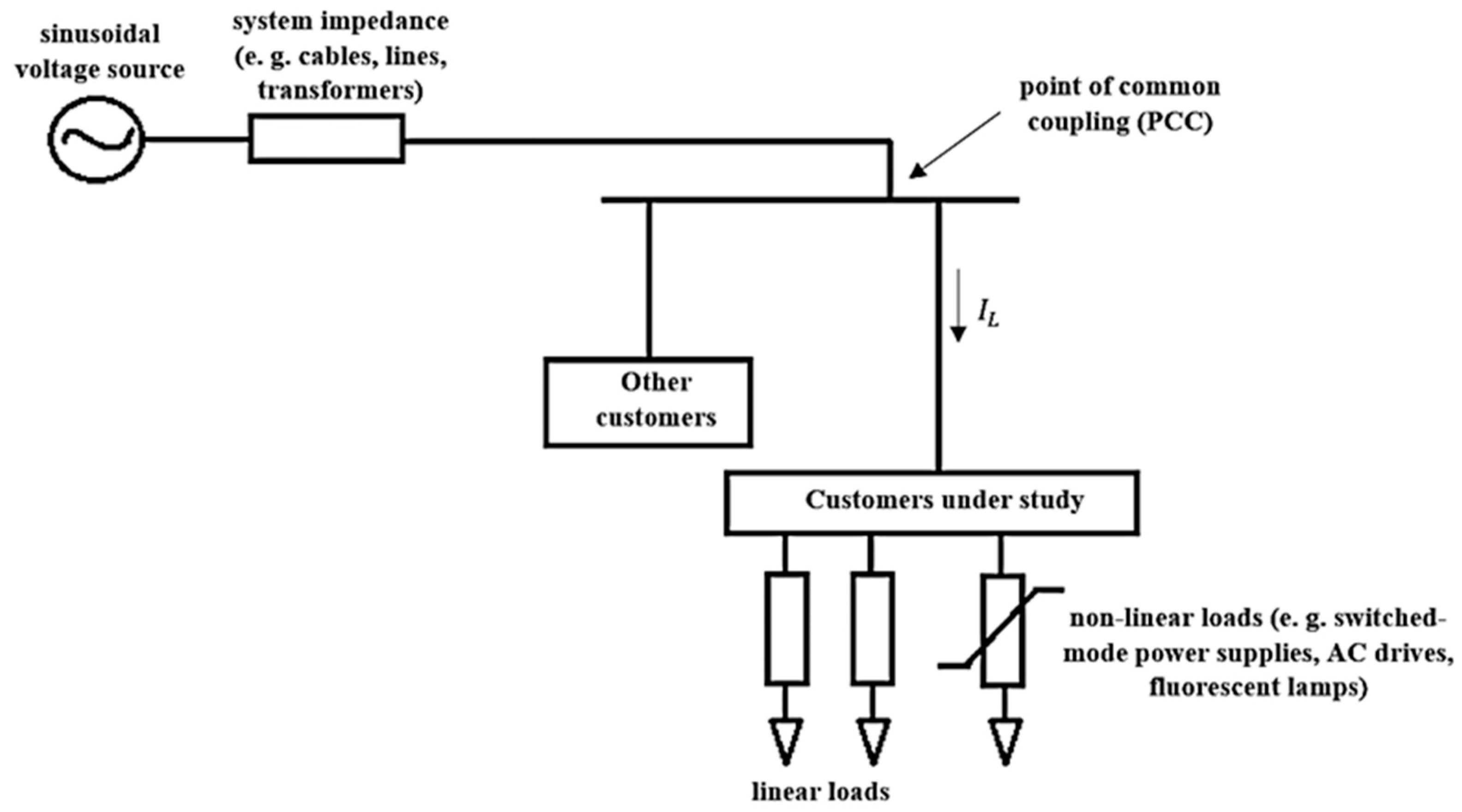
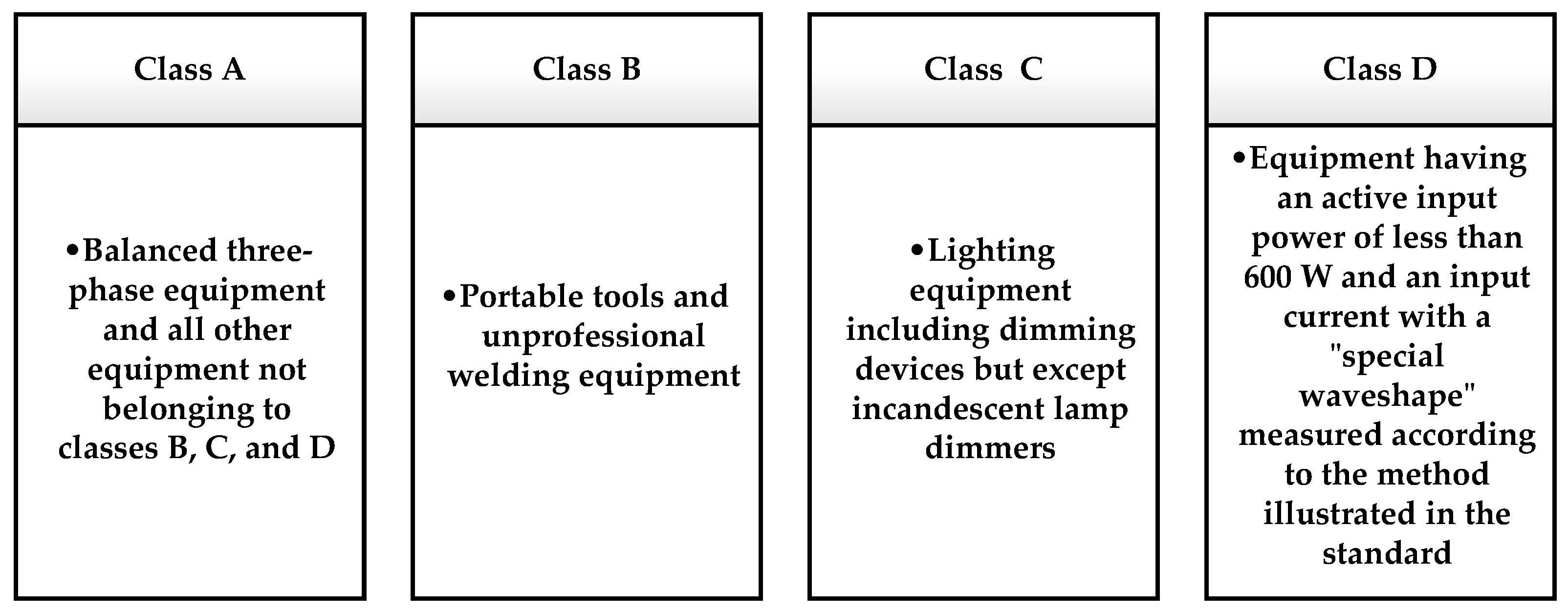
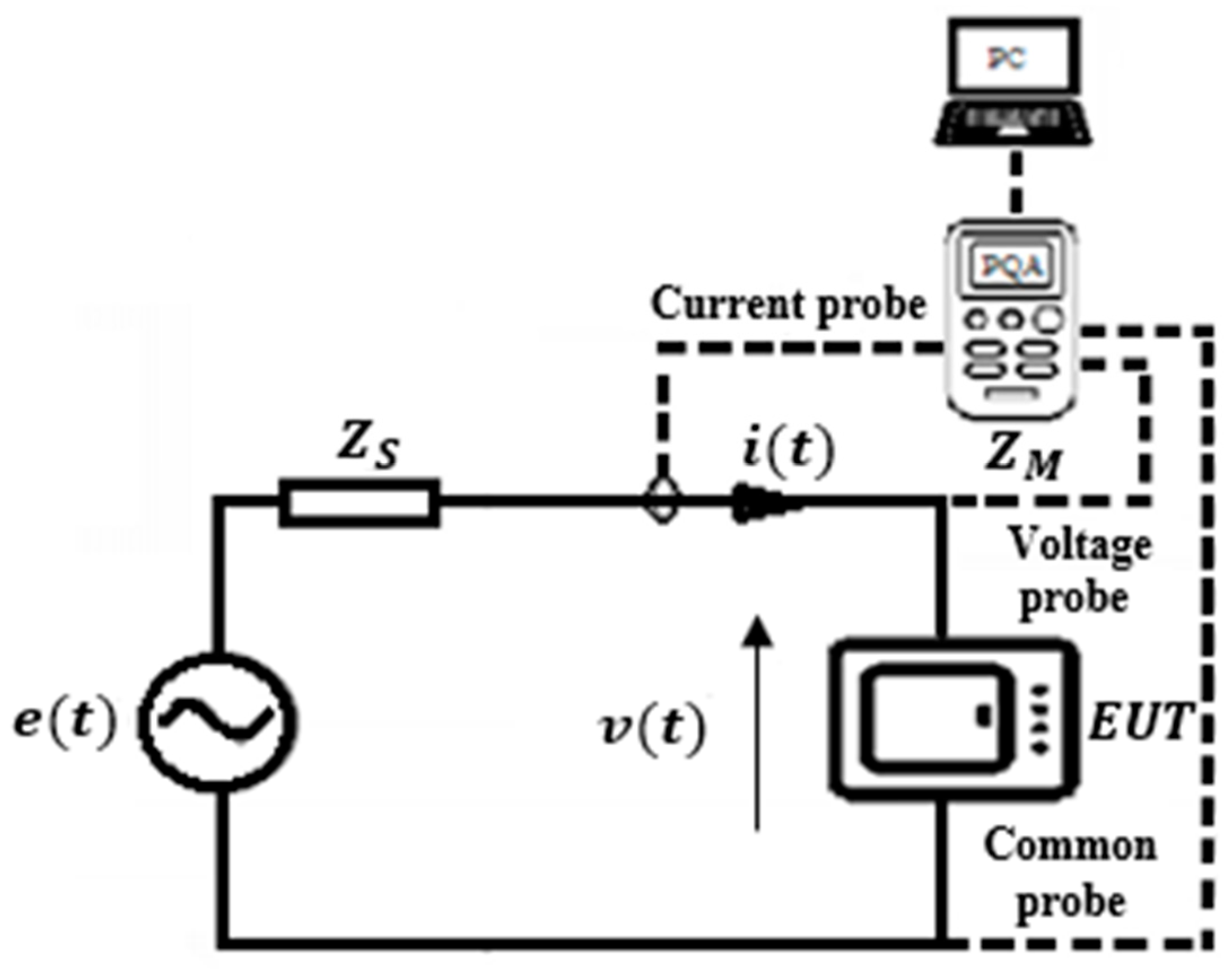

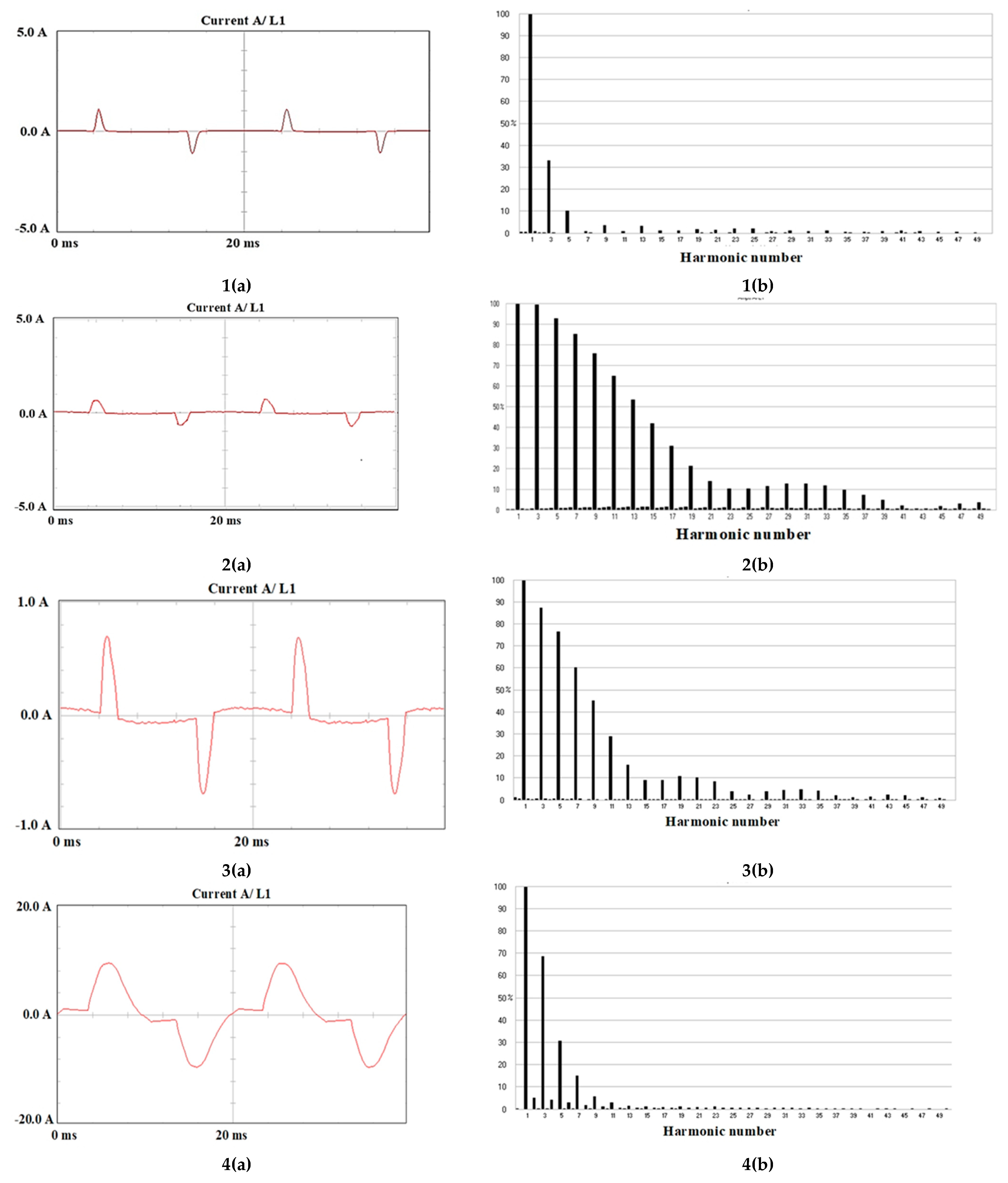

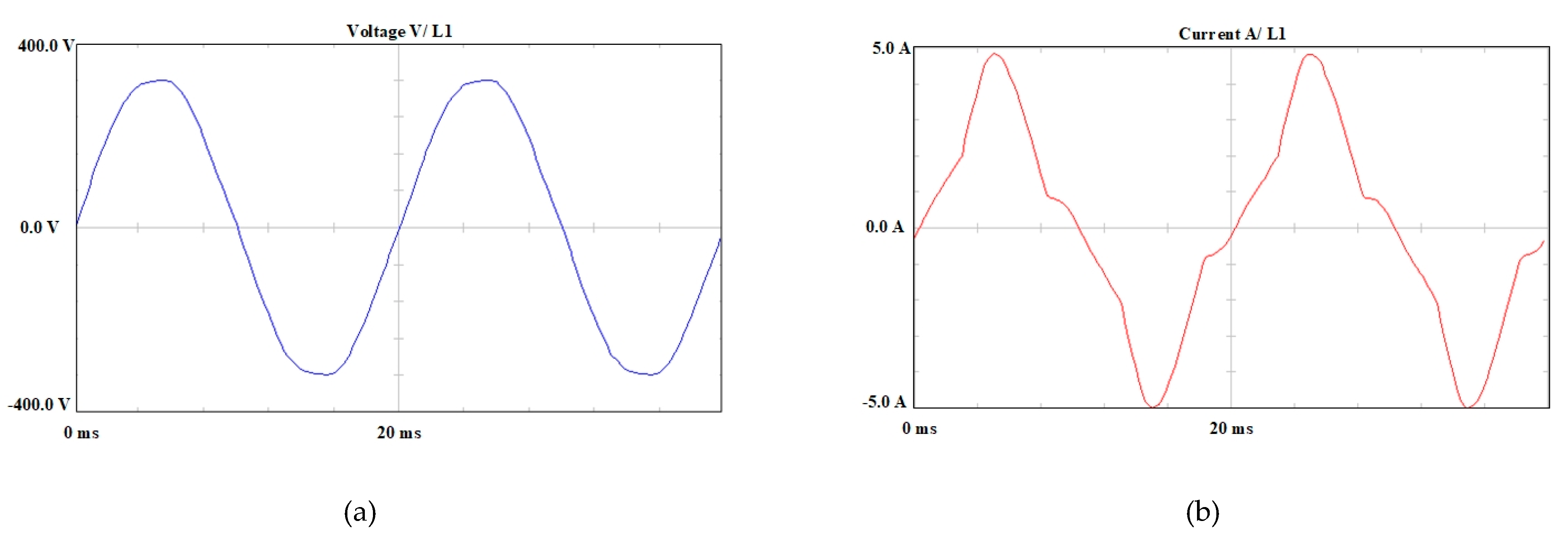
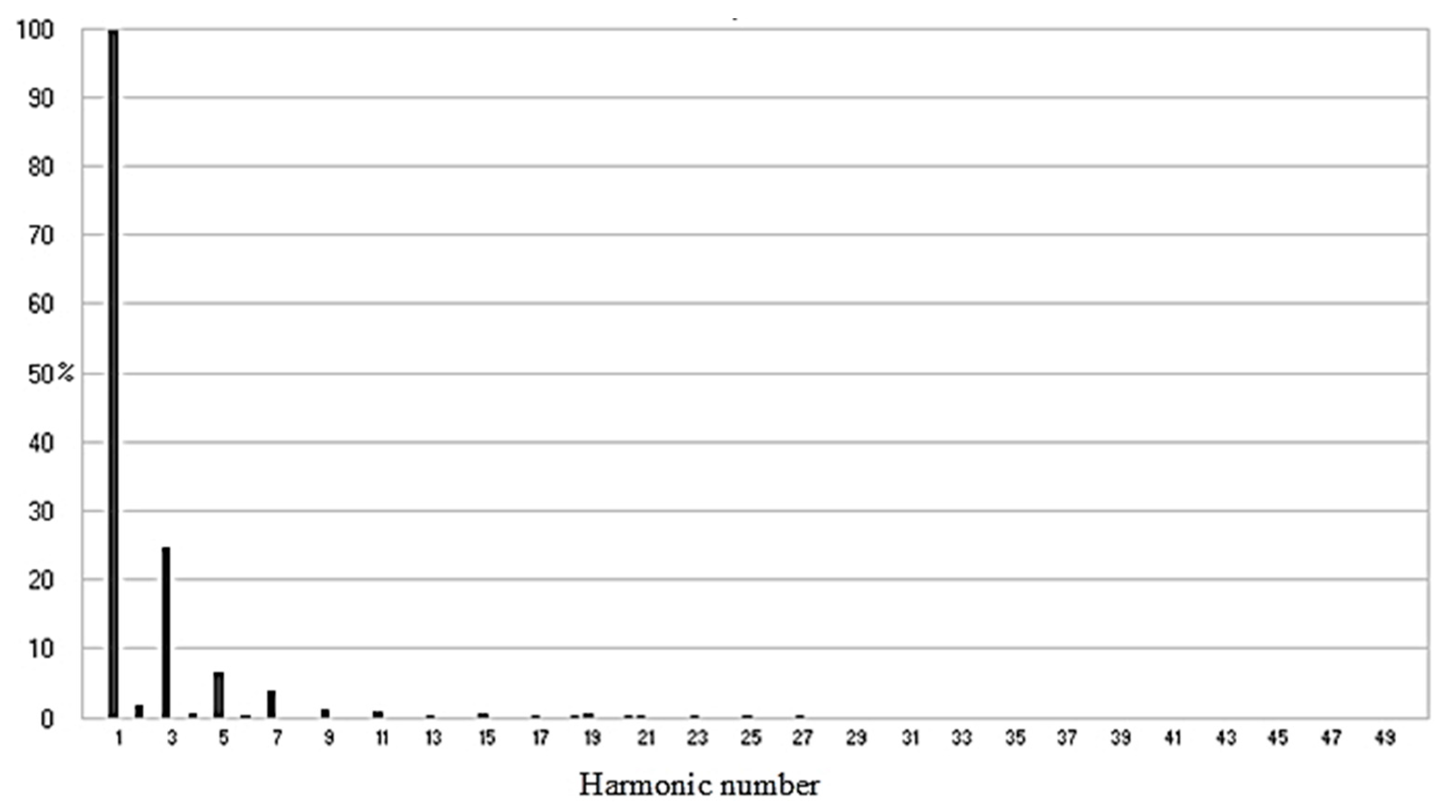
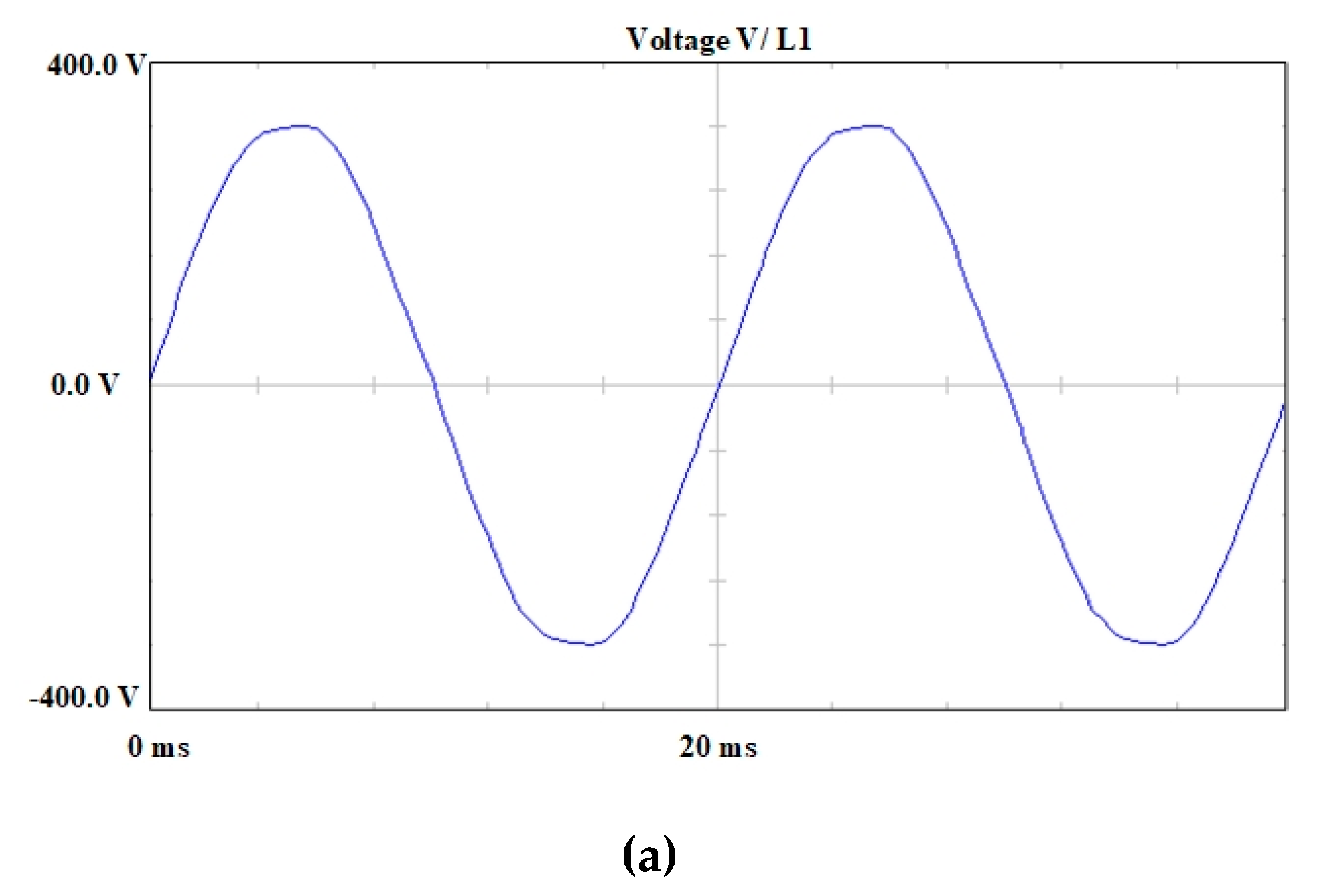
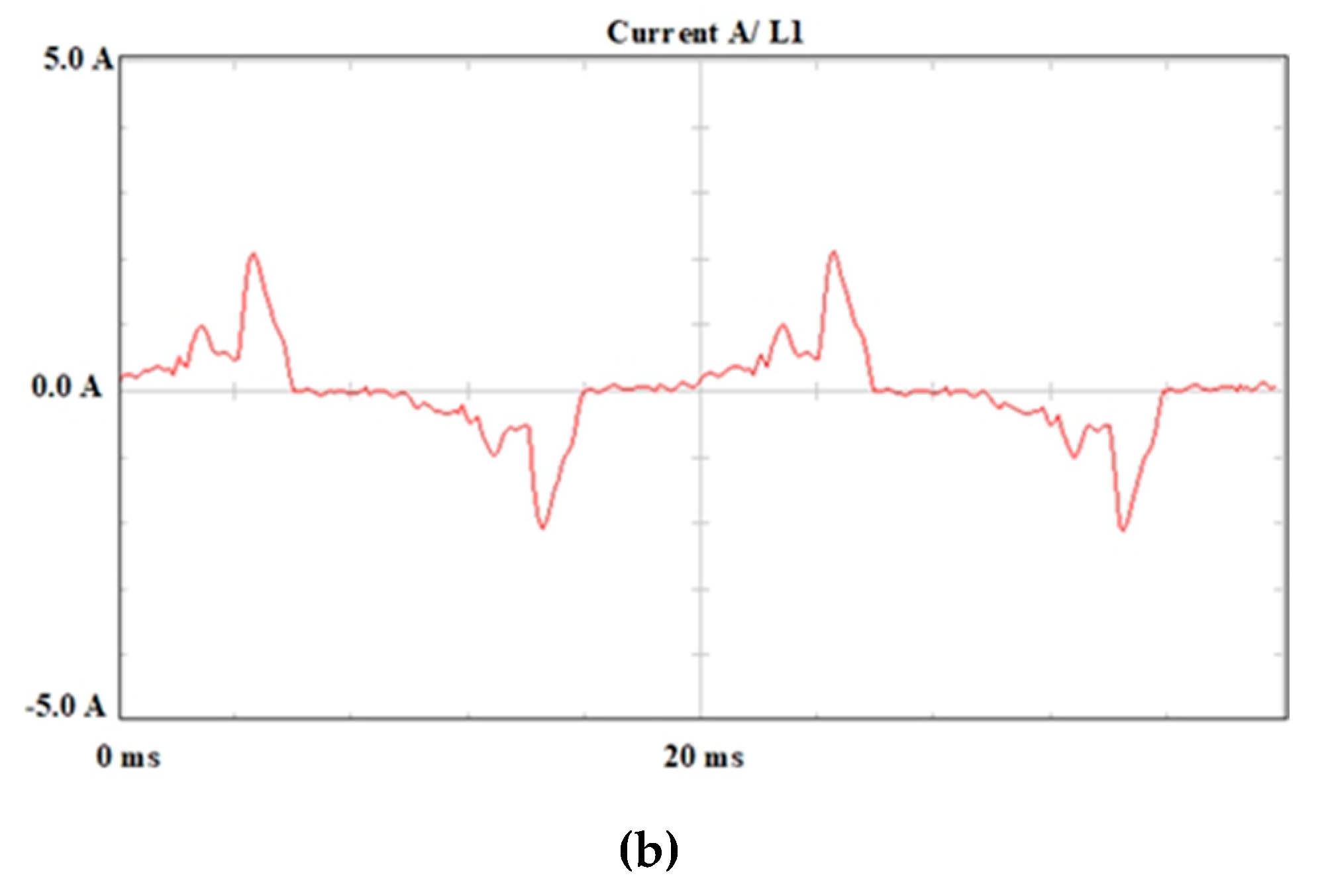

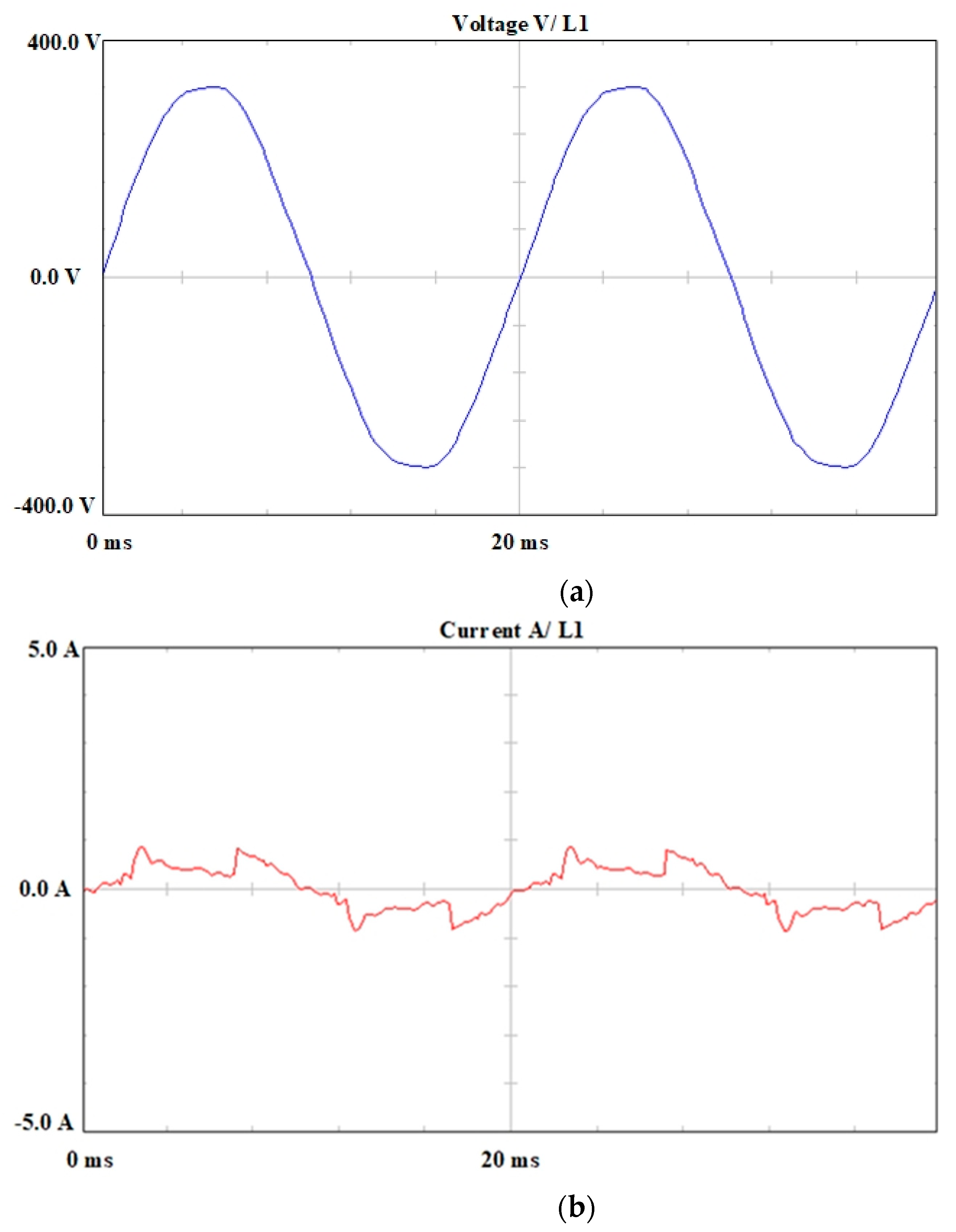
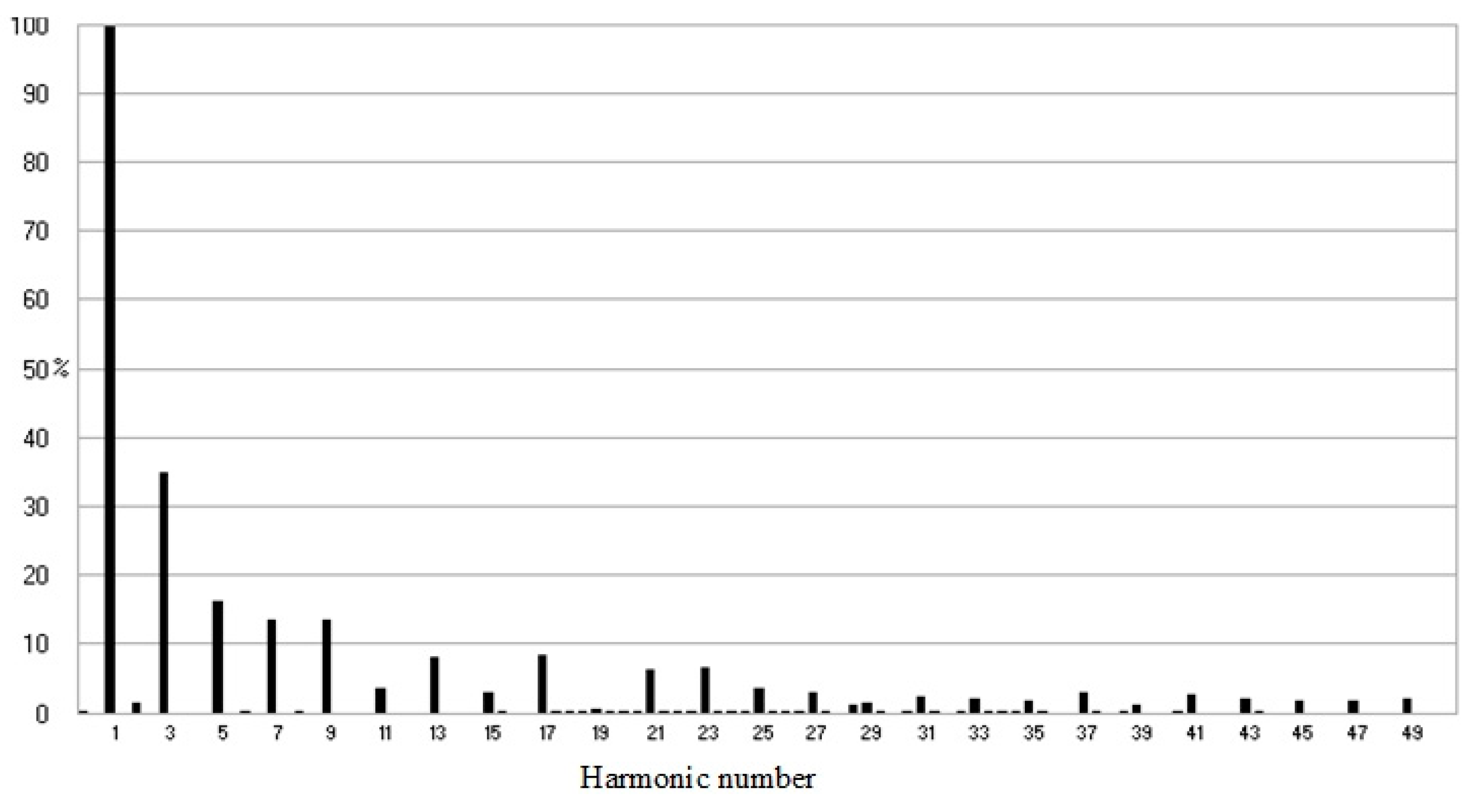
| No. | Type | Brand | Model | I (A) | P (W) |
|---|---|---|---|---|---|
| 1 | Laptop charger (AC Power Adapter) | Samsung | A10–090P1A | 1.5 | 90 |
| 2 | Smartphone Charger | Samsung | EP–TA20EWE | 0.5 | 0.1 |
| 3 | Desktop Copier (standby mode) | Canon | IR2016 | 2.5 | 3.6 |
| 4 | LCD monitor–20″ | LG | L204WT | 1.0 | 45 |
| 5 | Vacuum cleaner | Zelmer | 321.0.E01E | 6.0 | 1200 |
| 6 | Coffee machine | Krups | EA81 | 5.5 | 1450 |
| 7 | Microwave oven | FIF | MD 42035 | 6.5 | 800 |
| 8 | Compact fluorescent lamp | OSRAM | 20 W/865 | 0.2 | 20 |
| 9 | Fluorescent lamp type T8 | Philips | TLD 18 W 830 | 0.36 | 18 |
| 10 | High intensity discharge lamp | Philips | ML 160W E27 | 0.73 | 160 |
| 11 | Dimmer and incandescent lamp | F&F | SCO–812 | 1.5 | 60 |
| No. | Type of Loads | Group of Loads |
|---|---|---|
| 1 | Household | LCD monitor–20″ Caffe machine Compact fluorescent lamp Microwave AC Power Adapter (Charger) Vacuum cleaner |
| 2 | Office | LCD monitor–20″ Fluorescent lamp type T8 Compact fluorescent lamp Desktop Copier AC Power Adapter (Charger) Adaptive Fast Smartphone Charger |
| 3 | Lighting | Compact fluorescent lamp Fluorescent lamp type T8 High–intensity discharge lamp Dimmer and incandescent lamp |
| No. | Appliance | |
|---|---|---|
| 1 | AC Power Adapter | |
| 2 | Smartphone Charger | |
| 3 | LCD monitor–20″ | |
| 4 | Vacuum cleaner | |
| 5 | Microwave oven | |
| 6 | Compact fluorescent lamp | |
| 7 | Dimmer and incandescent lamp |
Publisher’s Note: MDPI stays neutral with regard to jurisdictional claims in published maps and institutional affiliations. |
© 2021 by the authors. Licensee MDPI, Basel, Switzerland. This article is an open access article distributed under the terms and conditions of the Creative Commons Attribution (CC BY) license (https://creativecommons.org/licenses/by/4.0/).
Share and Cite
Michalec, Ł.; Jasiński, M.; Sikorski, T.; Leonowicz, Z.; Jasiński, Ł.; Suresh, V. Impact of Harmonic Currents of Nonlinear Loads on Power Quality of a Low Voltage Network–Review and Case Study. Energies 2021, 14, 3665. https://doi.org/10.3390/en14123665
Michalec Ł, Jasiński M, Sikorski T, Leonowicz Z, Jasiński Ł, Suresh V. Impact of Harmonic Currents of Nonlinear Loads on Power Quality of a Low Voltage Network–Review and Case Study. Energies. 2021; 14(12):3665. https://doi.org/10.3390/en14123665
Chicago/Turabian StyleMichalec, Łukasz, Michał Jasiński, Tomasz Sikorski, Zbigniew Leonowicz, Łukasz Jasiński, and Vishnu Suresh. 2021. "Impact of Harmonic Currents of Nonlinear Loads on Power Quality of a Low Voltage Network–Review and Case Study" Energies 14, no. 12: 3665. https://doi.org/10.3390/en14123665
APA StyleMichalec, Ł., Jasiński, M., Sikorski, T., Leonowicz, Z., Jasiński, Ł., & Suresh, V. (2021). Impact of Harmonic Currents of Nonlinear Loads on Power Quality of a Low Voltage Network–Review and Case Study. Energies, 14(12), 3665. https://doi.org/10.3390/en14123665










